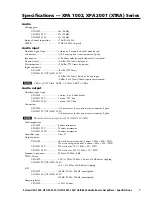
17
The 610 Preamp
The 2-610 was inspired by the Putnam-designed 610 console built in 1960 for his United Recording facility at
6050 Sunset Boulevard in Hollywood (now Ocean Way). As was the case with most of Putnam’s innovations, the
610 was the pragmatic upshot of a recurring problem in the studio: how to fix a console without interrupting a
session. The traditional console of the time was a one-piece control surface with all components connected via
patch cords. If a problem occurred, the session came to a halt while the console was dismantled. Putnam’s
solution was to build a mic-pre with gain control, echo send and adjustable EQ on one modular chassis using a
printed circuit board. While modular consoles are commonplace today, the 610 was quite a breakthrough at the
time.
While the 610 was designed for practical reasons, it was aesthetic appeal that made it popular with the re-
cording artists who frequented United and Western in the 60’s. The character of the mic-pre in particular made
it favorite of engineers like Bruce Swedien, Bruce Botnick, Lee Hershberg and Jack Joseph Puig; and artists
including Sarah Vaughan, Frank Sinatra, Ray Charles, and The Beach Boys. Swedien describes the character of
the preamp as “clear and open” and “very musical”. Studios 2 and 3 at Western, which featured the 610 con-
sole, were the site of many classic recordings of the 60’s, including the Mamas and the Papas (Bones Howe),
Up, Up and Away by the Fifth Dimension, Herb Alpert, Sergio Mendes (Bruce Botnick), and of course Pet Sounds.
Legendary engineer Wally Heider, manager of remote recording at United, used his 610 console to record many
live recordings including Peter, Paul and Mary “In Concert” (1964), Wes Montgomery’s “Full House” (1962), and
all of the Smothers Brothers Live albums. Heider’s console was later acquired by Paul McManus in 1987, and
spent a decade restoring it. [We thank Paul for his efforts and his contribution to our efforts to trace the history
of the 610.]
At least one 610 module is still in use at Ocean Way. Allen Sides, who purchased the studio from Putnam to
open Ocean Way, personally traveled to Hawaii to collect the 610 console that was used to record the live “Ha-
waii Calls” broadcasts. Jack Joseph Puig has been ensconced in Studio A with the 610 (and a stunning collec-
tion of vintage gear) where he has applied the vintage touch to acts including Beck, Hole, Counting Crows, Goo
Goo Dolls, No Doubt, Green Day and Jellyfish.
Classic Compressors
The LA-2A and 1176 compressor/limiters long ago achieved classic status. They’re a given in almost any studio
in the world - relied upon daily by engineers whose styles range from rock to rap, classical to country and
everything in between. With so many newer products on the market to choose from, it’s worth looking at the
reasons why these classics remain a necessary part of any professional studio’s outboard equipment collection.
The basic concept of a compressor/limiter is of course, relatively simple. It’s a device in which the gain of a
circuit is automatically adjusted using a predetermined ratio that acts in response to the input signal level. A
compressor/limiter “rides gain” like a recording engineer does by hand with the fader of a console: it keeps the
volume up during softer sections and brings it down when the signal gets louder. The dynamic processing that
occurs at ratios below 10 or 12 to one is generally referred to as compression; above that it’s known as limit-
ing. Modern day compressors offer a great degree of programmability and flexibility while older devices such as
the 1176 and the LA-2A are more straightforward in their design. Perhaps it is this fact that has contributed to
their appealing sound and the longevity of their popularity.
The 1176LN
The original Universal Audio 1176LN was a major breakthrough in limiter technology - the first true peak limiter
with all transistor circuitry offering superior performance and a signature sound. Evolved from the popular



































